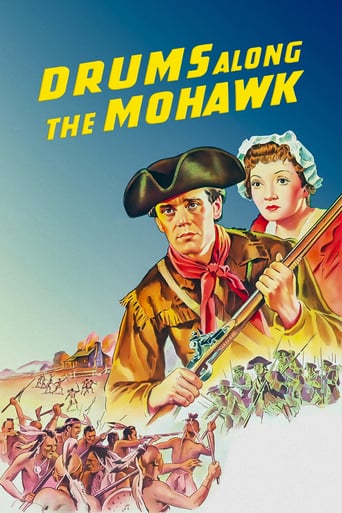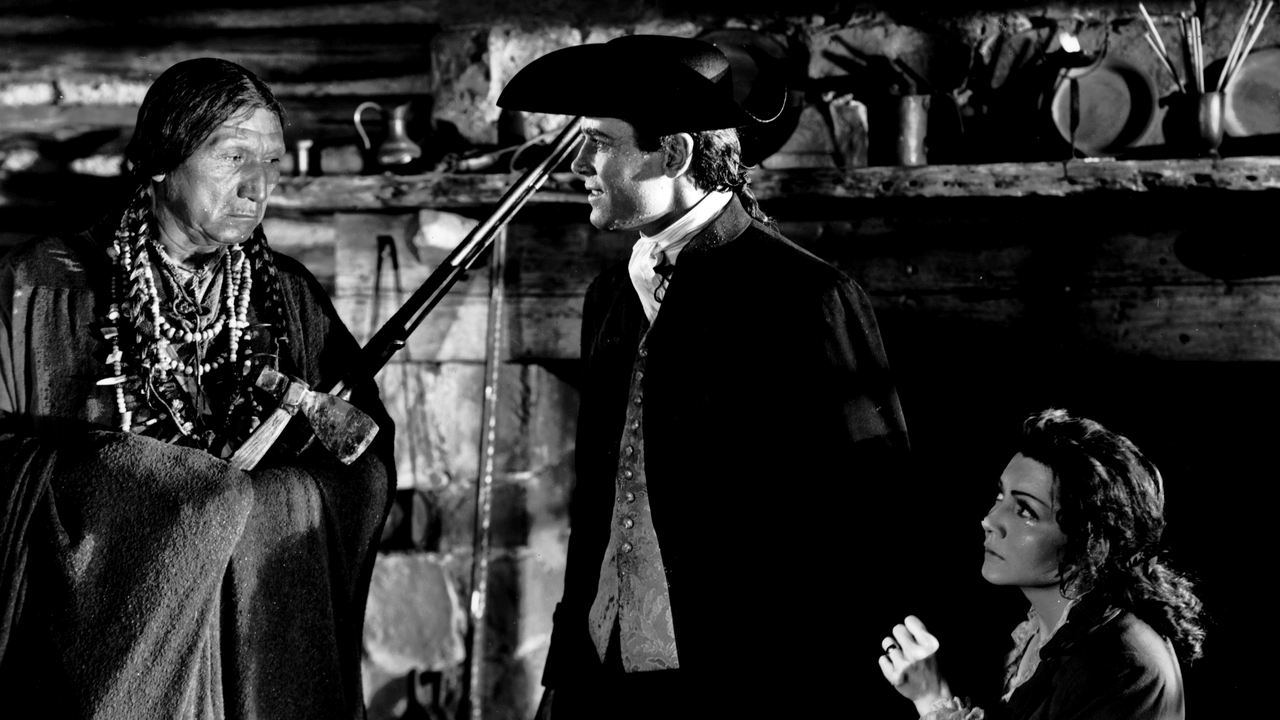ma-cortes
Awesome and marvelous Western by the great John Ford and deemed by many to be his early best . 1776 , in American revolutionary , Albany , Gilbert 'Gil' Martin (Henry Fonda who was real descendant of the Fondas that settled in the Mohawk Valley in the mid 17th Century) marries the beautiful Magdelana 'Lana', shortly before the revolutionary war , and takes her West to begin a homestead in the Mohawk Valley , in Upstate New York . There took place bloody battles as Battle of German Flats in the Mohawk Valley as part of the loyalist Butler's Rangers , and the Battle of Oriskany . As they settle their homestead when the war begins and both of whom become involved into a terrible conflict . As both sides battle relentlessly supported by Indians , as the Iroquois Confederation was split in its loyalties during the Revolution , the Oneidas sided with the Americans while the Mohawks and Senecas joined with the Hurons and Nipissing First Nation , Ojibwas and Algonquins on the side of the instigating British . For the next six years Gilbert battles in the war and while they attempt to establish their homestead . But it to be on fire and the young farmers , then , move and meet a grumpy old widow , Mrs. Mc Klennar (Edna May Oliver) , who is happy to put them up in her farm in exchange for help from both of them . Later on , Gil joins the minutemen , and after that , Indians commanded by the nasty Brit Caldwell (John Carradine) burn the farms and attack the rebellious colonists on a fort that is really besieged . But the violence and destruction of war catch up , and even the fort isn't guaranteed safe . And Gilbert carries out a long marathon foot leg through an Indian gauntlet . One of John Ford's early Western hits , it has come remarkable Colour cinematography by Bert Glennon and Ray Rennahan , dealing with pioneers hardships , and the expected , violent as well as impressive scenes about the Redskin siege . This nice and superb Western contains thoughtful characters , full of wide open space and dramatic moments . Outdoors are pretty good and well photographed , story first-rate and powerful told too . Here John Ford and Henry Fonda reached the peak of their successful and fundamental screen collaboration . Thought-provoking , insightful screenplay portraying in depth characters and brooding events with interesting issues running beneath script surface . Over-the-top Western with trigger-taut drama , perfectly written by Lamar Trotti and uncredited collaboration by Nobel winner William Faulkner , being based on on the Walter Edmonds novel . The film relies heavily on the extremely sentimental relationship between the young marriage : Lana/Claudette Colbert and Gilbert Martin/Henry Fonda . Fine acting from Henry Fonda as a civilized man from the East coast colonies who finds himself a loving bride , and attractive Claudette Colbert who keeps her upper lip pretty stiff but she looses their expected baby . ¨Drums along the Mohawk¨ gets to ensemble a magnificent supporting cast , plenty of familiar faces , and Ford's regulars , such as : Edna May Oliver , John Carradine , Ward Bond , Francis Ford , Eddie Collins , Arthur Shields , Robert Lowery , Jessie Ralph , Jack Pennick , Russell Simpson and Chief John Big Tree . This classic and moving picture ranks as one of the main of John Ford's works , including settings , interpretations , cinematography all extraordinary . It contains Ford's usual themes as familiar feeling , a little bit enjoyable humor , friendship and sense of comradeship but also some cynicism and full of wide open spaces with breathtaking landscapes exceptionally filmed from Cook County , Pennsylvania , Aspen Mirror Lake , Duck Creek Village , Strawberry Point , Dixie National Forest, Wasatch Range , Cedar Utah USA . Furthermore , a sensitive , romantic and thrilling at times , musical score by the classic composer Alfred Newman . Marvelously shot Ford film with a lively look at the complex world of the colonialists , pioneers versus Indians , and adventure romance . This solid as well as patriotic motion picture was well directed , this is a grand , cunningly crafted entertainment , action-filled and jingoist saga about revolutionary America . Ford's prior and subsequent films to get great successes as ¨The stagecoach¨ , ¨The young Mr. Lincoln¨ and the cavalry trilogy as ¨Fort Apache¨, ¨They wore yellow ribbon¨ and ¨Rio Grande¨. And , his posterior ¨Two rode together¨ has a similar plot to ¨The searchers¨ though the Ford's vision about West is pretty cynical and less idealist .
dominator494
Drums Along the Mohawk (1939)is one of three films John Ford directed in 1939. The two others were Stagecoach and Young Mr. Lincoln. Drums Along the Mohawk is the one out of the three most overlooked according to scholars. This was also John Fords first film in color, and had excellent cinematography that captures mountains and scenery extremely well while at the same time capturing the harsh life in the west. It was certainly deserving of its Oscar nomination for best color cinematography. The film staged action scenes extremely well especially the long chase involving Gil and the Indians. Although this film is not Fords most famous, it still shows his skill in cinematography, and film.
LeonLouisRicci
There are a Couple Things that make this an Endurable John Ford Sermon. The Early Technicolor, and a Few Good Scenes of Tension and Battle. What is Hardly Endurable is the Preaching and Overacting that is Typical Ford. The Overt Sentimentality and Overplaying Certain Aspects that were so Near and Dear to the Director.The Birthing Baby Scene just goes on Forever and becomes Somewhat Intolerable, the Cartoonish Characters like the Happy Drunk (even while being tortured and burned to death), Patriotism as Religion, and just so much Heavy Handedness. Then there's Propaganda like Fonda's (read American) Proclaiming, "No Indian alive can outrun me!".But it is an Entertaining Film and the Final Siege at the Fort is Stunning in its Gripping Brutality. Fonda and Colbert are All Right and Edna May Oliver is again a Scene Stealer, but the Supporting Cast is nothing but a Silly Conglomerate of Overt Stereotypes and Overacting.Certainly Worth a Watch for the Aforementioned Good Parts, but Far from a Classic or Enticing Cinema. That is Typical of most John Ford Stuff. Some rather Great Scenes, but His Movies as a Complete Piece of Art, Generally with a Few Exceptions, cannot Withstand the Weight of Ford's Ego.
Benoît A. Racine (benoit-3)
I first saw "Drums" dubbed in French at age 7 in front of an old small-screen black and white early TV set in the fifties in my native Quebec. In spite of the bad quality of the print and the primitive technology, it struck me – even then - as elaborately engrossing. But its depictions of Indian attacks warped me for life. For all the political correctness talk of Aboriginal-sensitive commentaries that bemoan the fact that Indians are portrayed like the flying monkeys from "The Wizard of Oz", the fact remains that of the more than 300 native cultures in North America, Mohawks were the most violent and troublesome. They were s.o.b.'s then and they are s.o.b.'s now and forever getting into trouble with the laws of my native Quebec (which offered them asylum after the war and to this day), neighbouring Ontario and New York State. They may have fought against the Revolution but we were stuck with them for 250 years.It was quite a revelation to see the film again in the wondrous 2005 DVD restoration with its sound spatialised for stereo equipment. I saw the colours and the detail and heard the original English dialogue for the first time. The film has acquired a lot of new qualities to my eyes and ears during that viewing - even though the Mohawks were still the blood-thirsty bastards I remembered. I will try to name a few reasons for loving that film.THE RESTORATION AND PHOTOGRAPHY: The restorers worked from a well preserved early interpositive that they cleaned up electronically. Although the results can't compare with the wonders of the expensive ultra-resolution process where all three colour layers of Technicolor are realigned electronically, the image is still for the most part stunning and showing very little misregistration. The day-for-night scenes may be a little wanting in the contrast department, but, all in all, the DVD shows the viewer examples of what made Technicolor such a fascinating novelty. The director of photography takes loving care in giving the viewer his money's worth by showing landscapes, sunrises, sunsets, high noon, cloudy skies, clear skies, forest trails, interiors, thunderstorms, moonlight and candlelight in a way that black and white photography could only suggest. And everything gives the illusion of having been shot on location and mostly outdoors even when logic dictates that this is impossible.THE HISTORICAL INTEREST: There are very few films showing the reality (and the horror) of the Revolutionary War and its impact on frontier people. This film is a magnificent reconstruction. The Black servant Daisy and the good Indian Blue Back may be given short shrift all through the film but they are counted among the characters who proudly salute the new flag of the United States in the final scene when Gil says to his wife that there is still "a heap of work to do" to make this a real country. I also liked Alfred Newman using "Country Gardens" as a musical theme representing the gentility of the lifestyle – and the home country - the pioneers left behind.THE MUSIC: Alfred Newman is a rustic melodist but a very sophisticated musicologist and orchestrator. His music, while never calling attention to itself, does a wonderful job of underlining the numerous suspense scenes with intelligent commentary that has nothing to do with today's "fear music", which is all about percussion, electronic effects and high noise level. His work gives the film its soul through its drama, comedy, suspense and pathos.THE ACTORS: Henry Fonda – perfectly cast (his family actually founded the village of Fonda on the Mohawk River) - gives one of the best speeches of his career. Claudette Colbert, whom it can be suspected was offered the part for her box-office appeal and as a consolation prize for not doing "Gone With The Wind", renounces all mannerisms and compensates for bad casting by acting in a purely visceral and physical way. She succeeds in portraying a subservient and modest wife – which is quite a stretch for her. Edna May Oliver is also given a meaty part of a woman of courage and expression, which she manages to underplay and make real. All the other John Ford regulars (with special kudos to Ward Bond)are equally memorable in making the sometimes quirky and era-specific characters come to life.For all those reasons, this is a film worth preserving and seeing over and over again when one wants to get in touch with the real spirit of the American Revolution, the sacrifices it cost and what it was supposed to accomplish.


 AD
AD





